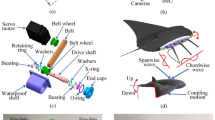Abstract
We make a thorough kinematic comparison of forward and backward swimming and maneuvering on a self-propelled robot platform that uses sub-carangiform swimming as the primary propulsor. An improved Central Pattern Generator (CPG) model allowing free adjustment of phase relationship and directional bias is employed to achieve flexible swimming and smooth transition. Considering the characteristics of forward swimming in carangiform fish and backward swimming in anguilliform fish, various backward swimming patterns for the sub-carangiform robotic fish are suitably created by reversing the direction of propagating propulsive waves. Through a combined use of the CPG control and closed-loop swimming direction control strategy, flexible and precise turning maneuvers in both forward and backward swimming are implemented and compared. By contrast with forward swimming, backward swimming requires a higher frequency or an increased lateral displacement to reach the same relative swimming speed. Noticeably, the phase difference shows a greater impact on forward swimming than on backward swimming. Our observations also indicate that the robotic fish achieves a larger turning rate in forward maneuvering than in backward maneuvering, yet these two maneuvers display comparable turning precision.
Similar content being viewed by others
References
Bandyopadhyay P R. Trends in biorobotic autonomous undersea vehicles. IEEE Journal of Oceanic Engineering, 2005, 30, 109–139.
Bandyopadhyay P R, Beal D N, Menozzi A. Biorobotic insights into how animals swim. The Journal of Experimental Biology, 2008, 211, 206–214.
Tan X. Autonomous robotic fish as mobile sensor platforms: challenges and potential solutions. Marine Technology Society Journal, 2011, 45, 31–40.
Yan Q, Han Z, Zhang S, Yang J. Parametric research of experiments on a carangiform robotic fish. Journal of Bionic Engineering, 2008, 5, 95–101.
Liang J, Wang T, Wen L. Development of a two-joint robotic fish for real-world exploration. Journal of Field Robotics, 2011, 28, 70–79.
Liu J, Hu H. Biological inspiration: from carangiform fish to multi-joint robotic fish. Journal of Bionic Engineering, 2010, 7, 35–48.
Nguyen P L, Do V P, Lee B R. Dynamic modeling of a non-uniform flexible tail for a robotic fish. Journal of Bionic Engineering, 2013, 10, 201–209.
Sfakiotakis M, Lane D M, Davies J B C. Review of fish swimming modes for aquatic locomotion. IEEE Journal of Oceanic Engineering, 1999, 24, 237–252.
Islam S S, Zelenin P V. Modifications of locomotor pattern underlying escape behavior in the lamprey. Journal of Neurophysiology, 2008, 99, 297–307.
Herrel A, Choi H, Schepper N D, Aerts P, Adriaens D. Kinematics of swimming in two burrowing anguilliform fishes. Zoology, 2011, 114, 78–84.
Niu X, Xu J, Ren Q, Wang Q. Locomotion generation and motion library design for an anguilliform robotic fish. Journal of Bionic Engineering, 2013, 10, 251–264.
Zhou C, Cao Z, Hou Z, Wang S, Tan M. Backward swimming gaits for a carangiform robotic fish. Neural Computing and Applications, 2013, 23, 2015–2021.
Zelenin P. Reticulospinal neurons controlling forward and backward swimming in the lamprey. Journal of Neurophysiology, 2011, 105, 1361–1371.
Ijspeert A J. Central pattern generators for locomotion control in animals and robots: a review. Neural Networks, 2008, 21, 642–653.
Ajallooeian M, Ahmadabadi M N, Araabi B N, Moradi H. Design, implementation and analysis of an alternation-based Central Pattern Generator for multidimensional trajectory generation. Robotics and Autonomous Systems, 2012, 60, 182–198.
Wu X, Ma S. Adaptive creeping locomotion of a CPG-controlled snake-like robot to environment change. Autonomous Robots, 2010, 28, 283–294.
Zhou C, Low K H. Design and locomotion control of a biomimetic underwater vehicle with fin propulsion. IEEE/ASME Transactions on Mechatronics, 2012, 17, 25–35.
Yu J, Wang M, Tan M, Zhang J. Three-dimensional swimming. IEEE Robotics and Automation Magazine, 2011, 18, 47–58.
Yu J, Wang L, Tan M. Geometric optimization of relative link lengths for biomimetic robotic fish. IEEE Transactions on Robotics, 2007, 23, 382–386.
Guertin P A. The mammalian central pattern generator for locomotion. Brain Research Reviews, 2009, 62, 45–56.
Buchli J, Ijspeert A J. Distributed central pattern generator model for robotics application based on phase sensitivity analysis. Biologically Inspired Approaches to Advanced Information Technology, 2004, 3141, 333–349.
Kane T. The use of Kane’s dynamical equations in robotics. International Journal of Robotics Research, 1983, 2, 3–21.
Wu Z, Yu J, Tan M. CPG parameter search for a biomimetic robotic fish based on particle swarm optimization. Proceedings of the IEEE International Conference on Robotics and Biomimetics, Guangzhou, China, 2012, 563–568.
D’AoUT K, Aerts P. A kinematic comparison of forward and backward swimming in the eel anguilla anguilla. The Journal of Experimental Biology, 1999, 202, 1511–1521.
Silver R, Boahen K, Grillner S, Kopell N, Olsen K L. Neu-rotech for neuroscience: Unifying concepts, organizing, principles, and emerging tools. The Journal of Neuroscience, 2007, 27, 11807–11819.
Long J H Jr, Shepherd W, Root R G. Maneuverability and reversible propulsion: How eel-like fish swim forward and backward using traveling body waves. Proceedings of 10th International Symposium Unmanned Untethered Submersible Technology (UUST), Specification Session Bio-Engineering, NH, USA, 1997, 118–134.
Su Z, Yu J, Tan M, Zhang J. Implementing flexible and fast turning maneuvers of a multijoint robotic fish. IEEE/ASME Transactions on Mechatronics, 2013, 99, 1–10.
Conte J, Modarres-Sadeghi Y, Watts M N, Hover F S, Triantafyllou M S. A fast-starting mechanical fish that accelerates at 40 m⋆s−2. Bioinspiration & Biomimetics, 2010, 5, 035004.
Tytell E D. The hydrodynamics of eel swimming II. Effect of swimming speed. The Journal of Experimental Biology, 2004, 207, 3265–3279.
Author information
Authors and Affiliations
Corresponding author
Rights and permissions
About this article
Cite this article
Wu, Z., Yu, J., Tan, M. et al. Kinematic Comparison of Forward and Backward Swimming and Maneuvering in a Self-Propelled Sub-Carangiform Robotic Fish. J Bionic Eng 11, 199–212 (2014). https://doi.org/10.1016/S1672-6529(14)60037-8
Published:
Issue Date:
DOI: https://doi.org/10.1016/S1672-6529(14)60037-8




